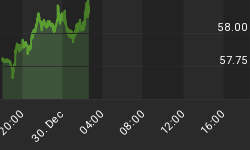Today the Bank of Canada (BOC) surprised the markets with a 25 basis point cut in its policy interest rate to 4.25%. This is the first decline in the BOC's policy rate since April 2004. The BOC cited downside risks to its inflation forecast as a justification for today's policy rate cut. The BOC strategically is attempting to keep the Canadian all-items CPI inflation rate around 2%. But for tactical policy decisions, the BOC relies more on a "core" measure of CPI inflation. As Chart 1 shows, Canadian "core" inflation has been in a downward trend in the second half of 2007, slowing to 1.8% in October on a year-over-year basis in October. In contrast, Canadian all-items inflation has been in a rising trend, up 2.4% year-over-year in October.
Chart 1
In one breath, the BOC cited downside risks to inflation as justification for today's policy rate cut. In another breath, the BOC stated: "Overall, the Canadian economy continues to operate above its production capacity. Given the strength of domestic demand and weak productivity growth, there continue to be upside risks to the Bank's inflation projection." [emphasis added]. So, which is it? Downside or upside risks to Canadian inflation?
Basically, the BOC sees downside risks to Canadian economic growth from tightened credit conditions north of THE border and tightened credit conditions in the Lower 48. Canada still depends mightily on exports to the U.S. for the sale of its production. With U.S. domestic demand growth softening and with the Canadian dollar having reached parity with its U.S. counterpart, the BOC is frightened that a potential U.S. recession could drag the Canadian economy under, too.
As this is being written (noon CST), the greenback has rallied 1.35% against the loonie. Whether the Bank of England (BOE) on Thursday follows the lead of one of its Dominion members on Thursday still is an open question. But the odds are that the BOE will begin a series of policy interest rate cuts soon in an attempt to forestall the onset of a UK recession. And after the BOE cuts, the European Central Bank will likely cut its policy rate. The Bank of Japan won't cut. It just won't raise its policy rate as it had intended to several months ago. These actions by developed-world central banks might cushion the foreign exchange value of the U.S. dollar.
As Chart 2 illustrates further, central banks in the developed world are cutting their policy interests as their all-items inflation rates go vertical. So, while fiat currencies float along in tandem as their supplies increase in tandem, all of them are likely to sink in value relative to the genuine "reserve currency" - gold. As this is commentary is being wrapped up (1:55 pm CST), the nearby gold futures contract in terms of U.S. dollars is up in price 1.90%. As developed-world central banks attempt to figuratively and literally "paper-over" the credit market implosion by creating more central bank money, the price of gold in terms of these fiat currencies - not just the U.S .dollar -- is likely to keep on rising.
Chart 2
















